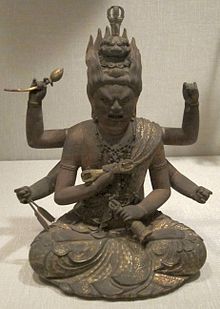- Aizen Myō-ō
-
En el culto budista Shingon de Japón, el dios Aizen Myō-ō (愛染明王?) es una personificación del amor divino que destruye las pasiones malignas. Se le suele representar de color rojo oscuro, con una cabeza y seis brazos que sostienen diversas armas y una corona con una cabeza de león. Se le considera el patrón del amor.
El mantra de Aizen Myō-ō es:
- 「おん まかあらぎゃ ばさら うしゅにしゃ ばさらさたば じゃうんばんこ」
- (on makaaragya basara ushunisha basarasataba jaunbanko).
Véase también
Categorías:- Budismo japonés
- Dioses de la mitología japonesa
- Deidades budistas
- Dioses del amor
Wikimedia foundation. 2010.

